Occasionally I rerun a favorite older blog post because few current readers have ever seen it. Today’s post is my 2,526th edition of Feathered Photography and the original version of this one was #6, published on December 26, 2010. For this version I’ve rewritten virtually all of the text, made major formatting changes and updated my copyright watermark.
Pied-billed Grebes have a chip on their shoulder that grows exponentially in size whenever food is involved.
They’re also full of personality but they’re quite small, relatively common and plainly colored so they don’t get a lot of attention from bird photographers. But over the years they’ve been one of my favorite subjects, largely because of their interesting and belligerent behaviors whenever food is involved.
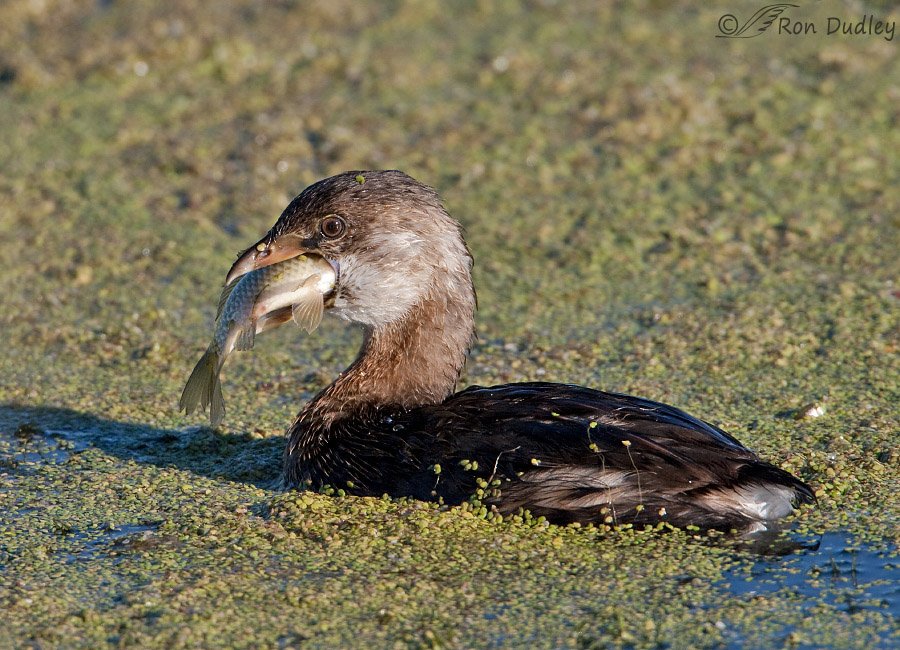
Young carp are their primary food source in many of the ponds I frequent (weather loaches come in a close second) but carp even at this tender age can be more than a mouthful for these very small grebes so they have to struggle to get many of them down the hatch. This grebe was taking a short break after an extended period of trying to swallow the carp.
.
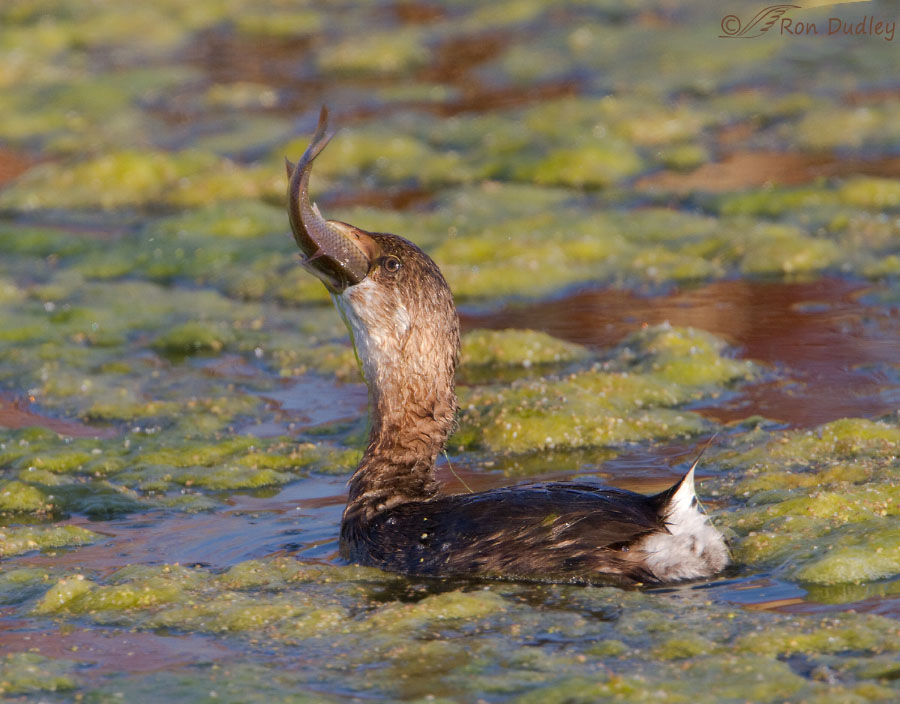
I’ve seen it take several minutes for a grebe to finally be able to swallow a fish this size and I’ve rarely if ever seen one give up on a meal because it was too big, although I suspect they occasionally release prey underwater that they can’t swallow.
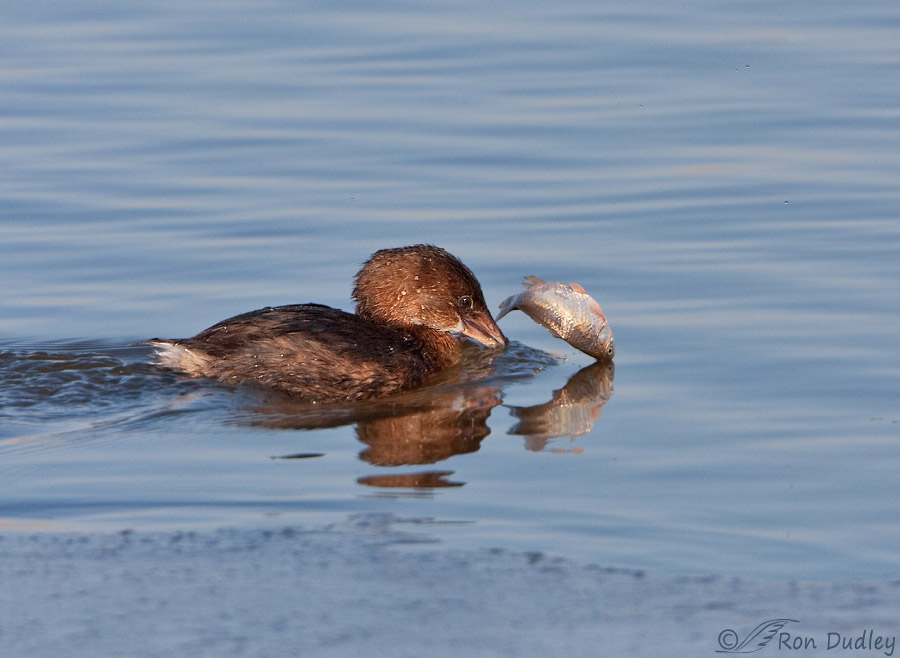
Fish are slippery, slimy food items and sometimes they get away from the grebe temporarily, although they usually seem to be recaptured. Sometimes the grebes appear to be playing with their food by deliberately releasing it into the water and then grasping it in their bills again. It’s even common for them to toss a fish or other food item into the air in front of them. In the case of this grebe I believe the fish simply slipped away but it was recaptured.
But believe me, they don’t play with their food when there are other grebes around because Pied-billed Grebes are notorious food thieves (kleptoparasites).
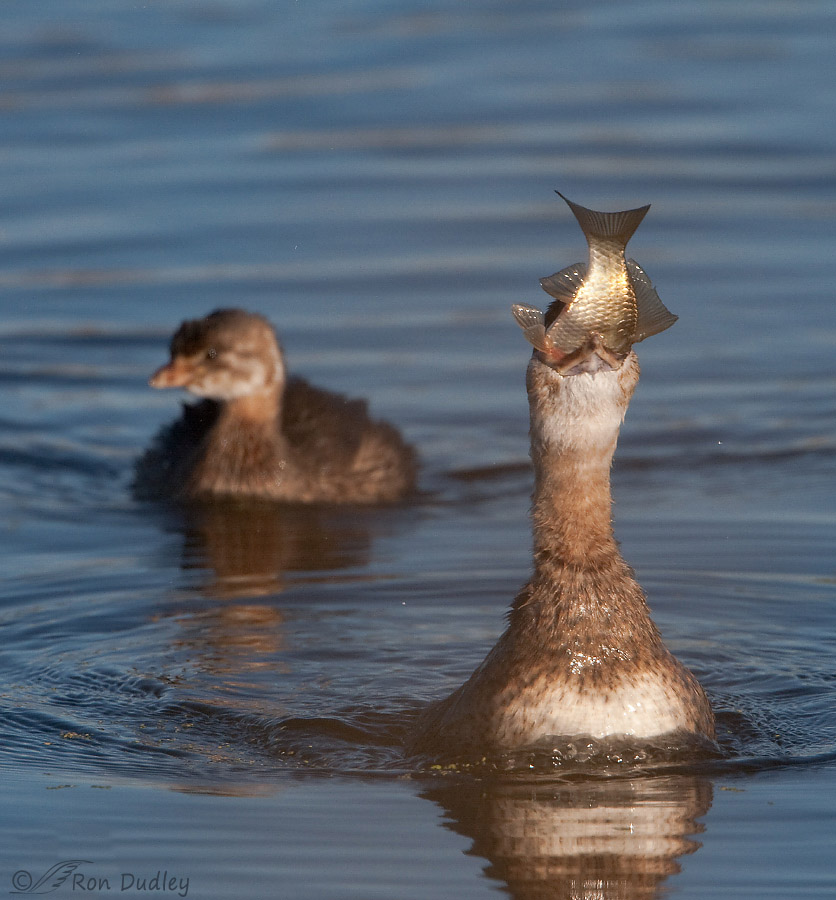
When there are other grebes in the vicinity the only order of business is swallowing the food as quickly as possible. Small fish go down easily and fast but a fish this size is a struggle and during the process the possessor of the fish is extremely vulnerable to attack.
Here the foreground grebe is trying mightily to get the carp down before its trailing competitor makes a move on the fish. If the potential thief gets too close or makes an aggressive move…
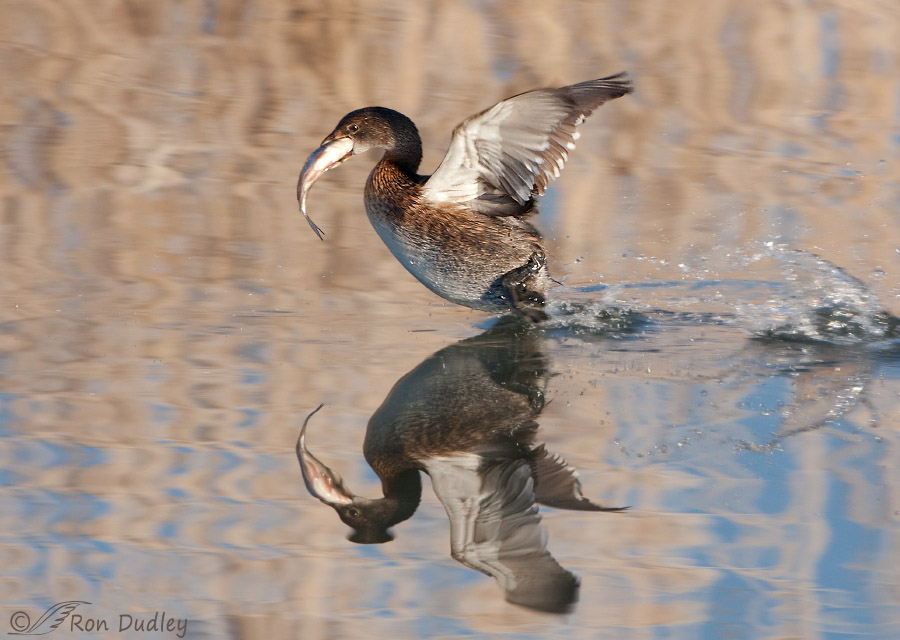
the result is usually explosive as both birds run across the water, one with the fish it’s trying to protect and the other with robbery on its mind. This behavior is difficult to photograph because these little rascals are so incredibly fast and their direction of travel is unpredictable and erratic.
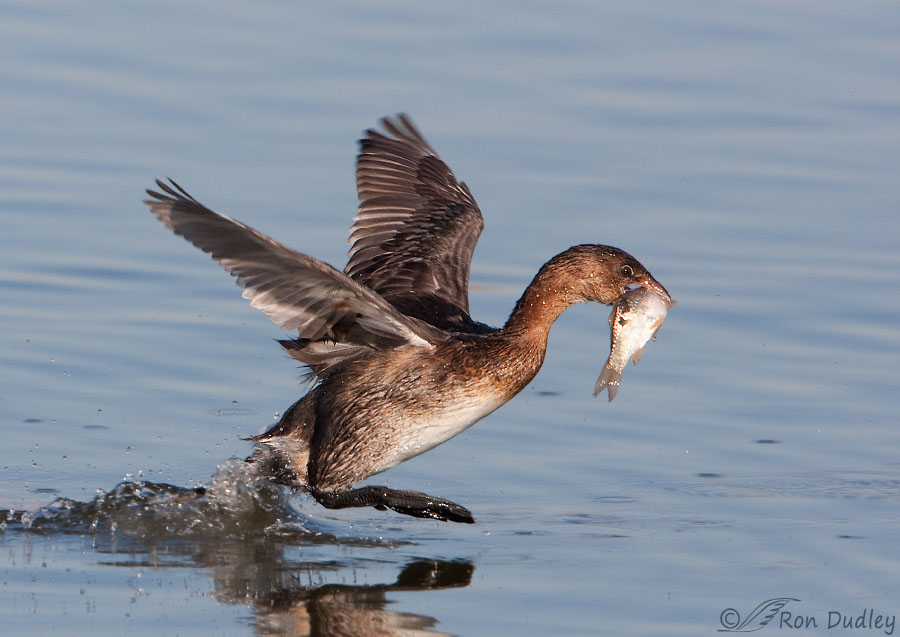
Another grebe attempting to escape its tormentor at blazing speed.
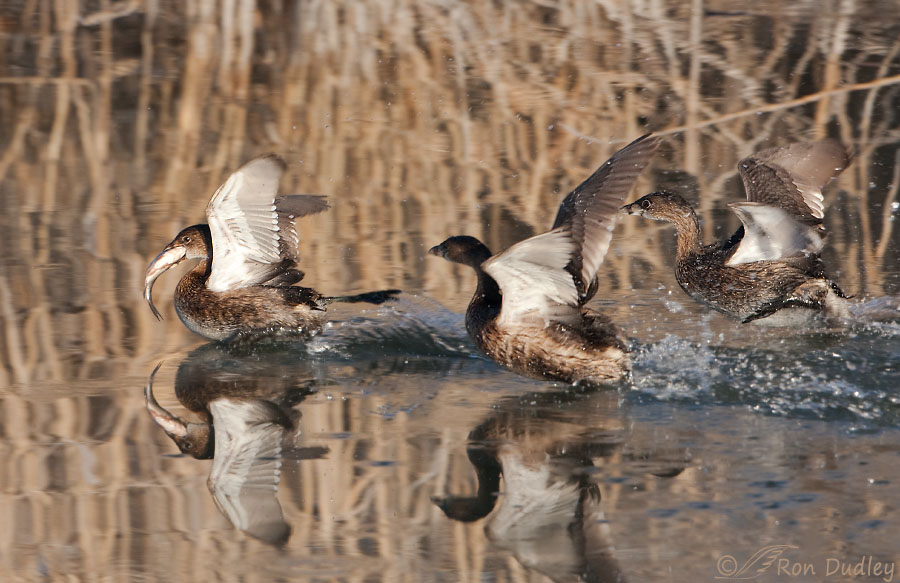
All hell breaks out when there are multiple grebes after the fish.
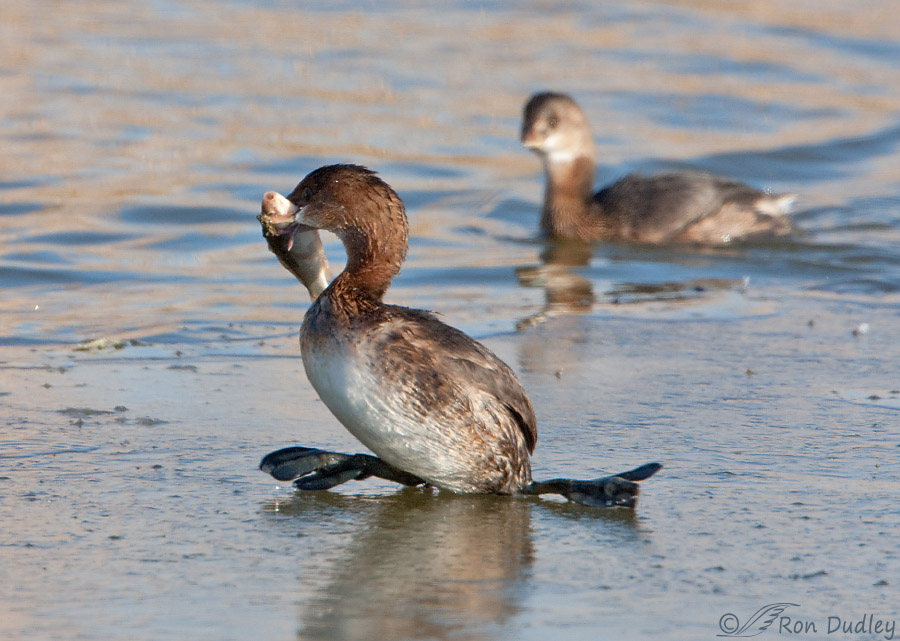
Here there are two interesting things going on. The grebe in the background obviously has larceny on its mind and the rightful owner of the fish has actually come out of the water and onto the ice to prevent the pilferage. Grebes rarely come out of the water because their legs are attached so far back on the body that they can’t really even walk. When they try they’re clumsy, inefficient and hilarious to watch.
Throw in the slippery ice this bird’s walking on and it’s a recipe for disaster for the photographer because spontaneous laughing while trying to shoot with a long lens typically produces soft images. And this one is noticeably soft so that should tell you something…
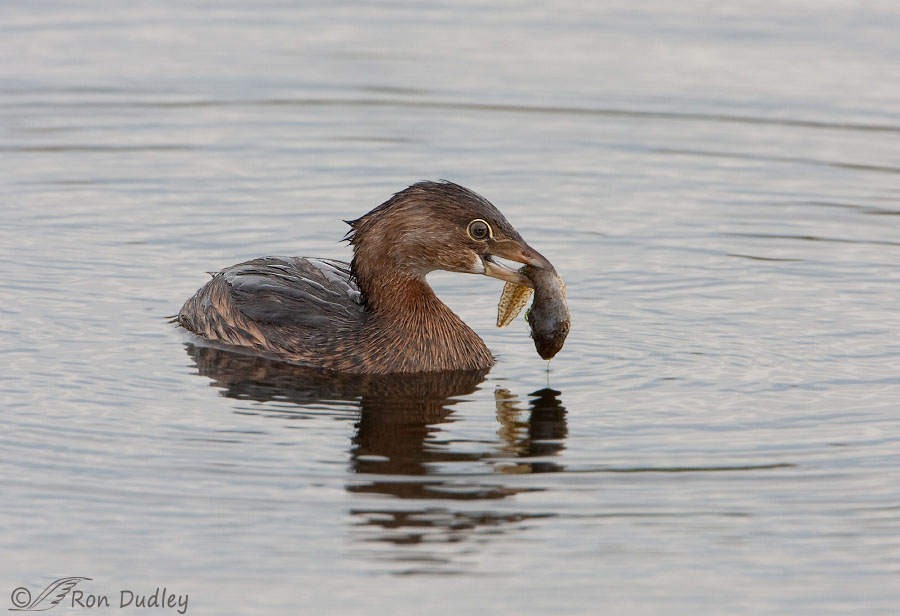 Pied-billed Grebes are opportunistic feeders and occasionally their diet includes tadpoles and even…
Pied-billed Grebes are opportunistic feeders and occasionally their diet includes tadpoles and even…
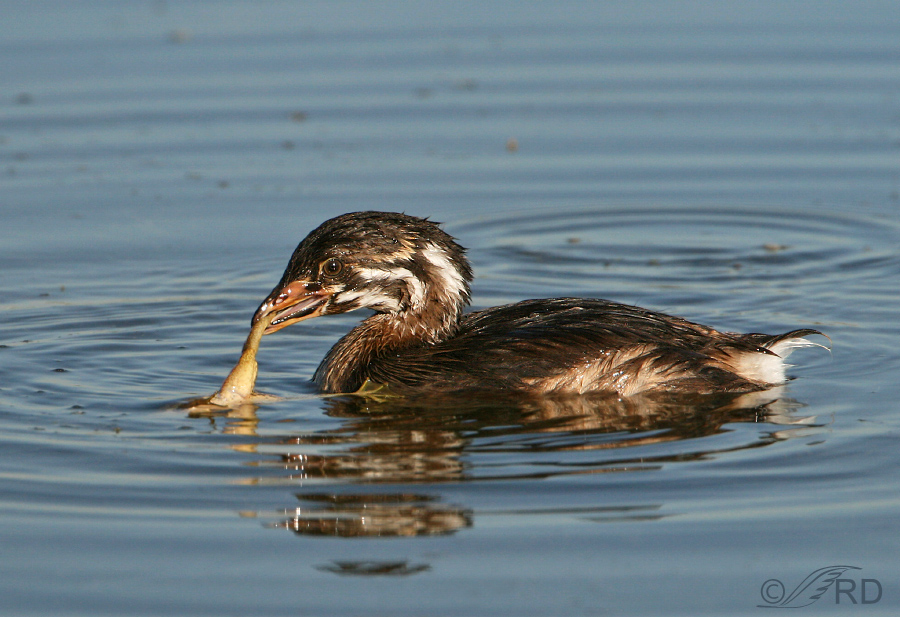
frogs. From the distinctive markings on its head this grebe is obviously a juvenile still learning the ropes.
Fish are swallowed whole but any decent sized prey item with limbs like frogs and crayfish is usually dismembered before swallowing.
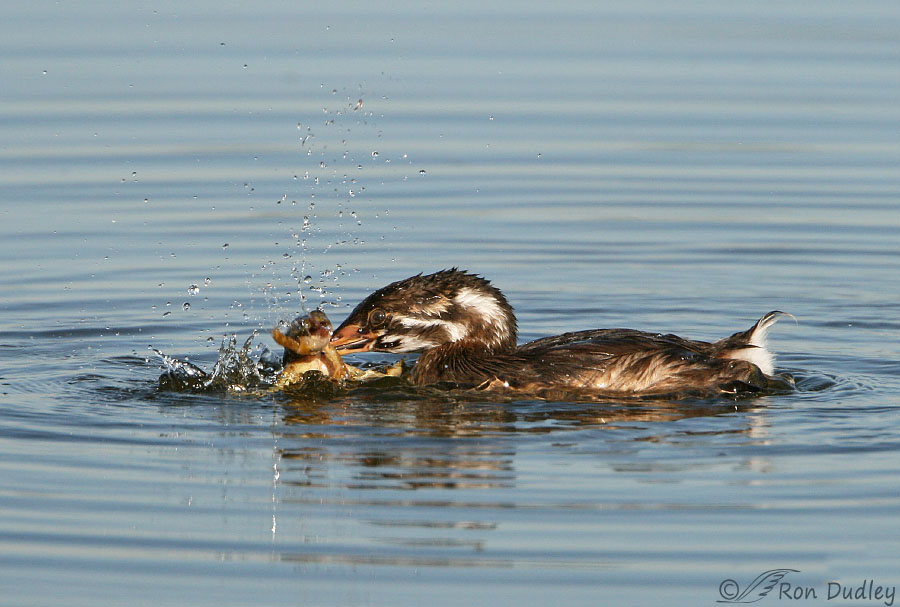
While attempting to tear legs off of the frog this youngster’s incredible shaking speed was impressive. It simply grabbed legs and then violently shook the frog until amputation occurred.
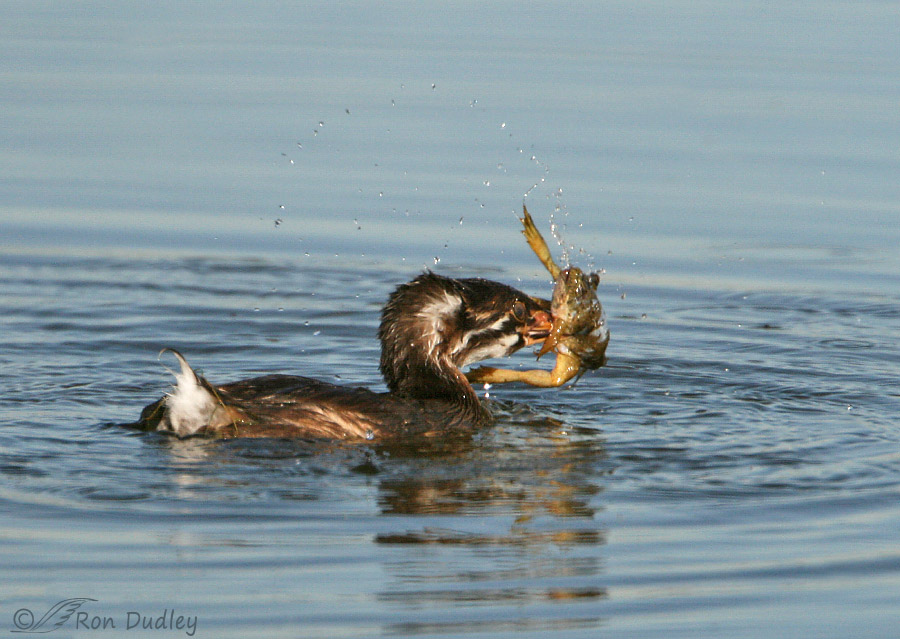
It took roughly five minutes for the grebe to get the frog dismembered to the point the pieces could be swallowed easily. I remember thinking, only half seriously, that it must have taken as much energy to dissect the frog as was gained from the meal.
Not much fun for the frog but it was a blast for the photographer.
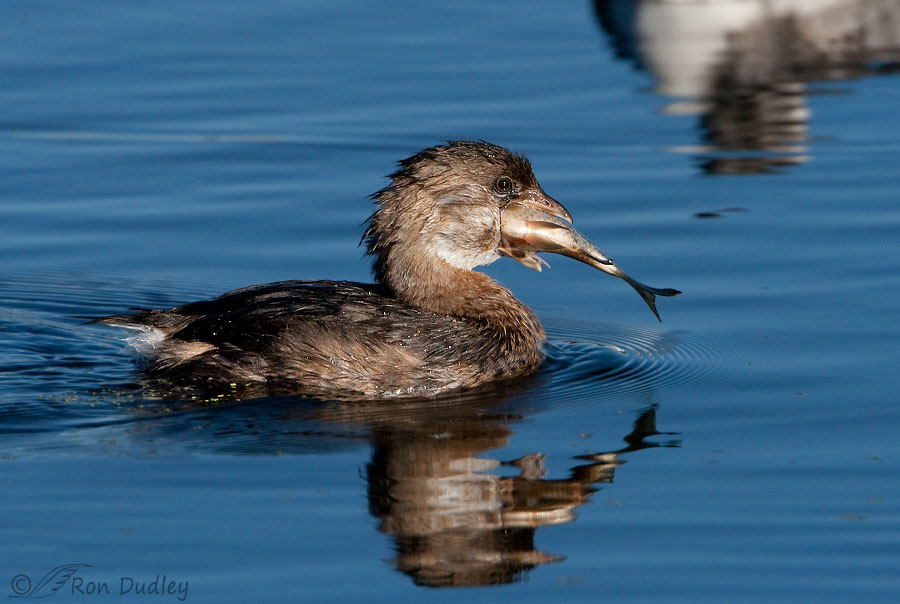 One final look at the size of a meal these tiny grebes are able to put away. The cheeks and even the eyes seem to be bulging with the effort but the fish eventually went down, to my amazement.
One final look at the size of a meal these tiny grebes are able to put away. The cheeks and even the eyes seem to be bulging with the effort but the fish eventually went down, to my amazement.
I have one suggestion for bird photographers, especially if you’re interested in behaviors. Don’t ignore Pied-billed Grebes, particularly when they’re feeding. You’ll be sorry…
Ron


What a wonderful series! I had to come home and look at them on the computer, the phone was just not doing justice to the fabulous shots. The ice shot is great. Grebes are a favorite of mine, I think it’s the back placed legs that make them adorable for me. And again the pied-billed feel great to hold, such nice round bodies, fits nicely in your hands. They can have a wicked nip though if you are not careful.
I’ll bet they can, April. I’ve seen that bill cause serious damage to prey and I think I remember reading that they’re known for strong jaws for their size.
Easier said than done! I swear all the grebes I’ve encountered have a preternatural ability to know when the shutter is about to be released, even when I don’t think they’ve spotted me. I have a lot more photos of the spot a grebe was than the bird!
My favorites are actually all instances where I was trying to photograph a grebe, gave up and switched subjects, and then had the grebe photobomb me, usually with a very smug look on its face!
I feel like I’ve seen both pied billed grebes and common mergansers give up on fish that they had spent several minutes trying to swallow. Perhaps they’re just making the final gulp with the prey underwater though?
My favorite example of kleptoparasitism around here are gadwalls and coots. Coots are such feisty little creatures, they always seem so outraged when their hard won salad gets pilfered!
Thanks Ron, fantastic shots as always, and few things are as amusing as a grebe out of water!
Pangolin, I can tell just from your first two paragraphs that you’ve spent significant time with grebes. You have them pegged!
I grew up hearing the phrase ‘eyes bigger than his/her stomach’. Father was wrong there. Not bigger than the stomach, but definitely a challenge for the throat. I do wonder though whether the prey that is released as too large survives the encounter.
Loved this series and your most excellent commentary, and am now feeling a tad guilty for takiing pleasure in the death of the frog/carp/loach.
Your photos And your charming, hilarious commentary made my day!!!
And your kind comment helped to make mine, Eloise. Thank you.
DYNAMIC series ! #4, “foreground” Grebe made me laugh out loud……..I wonder if they ever have digestion problems from having to run for it while they’re trying
simultaneously to get the meal down the hatch……..
#4 always makes me laugh too, Kris. Wonder if he burped after he got it down…
Wonderful series, Ron, especially the Grebe on ice doing his best penguin impression. Pity the poor frog, though!
Yup, that frog must have had better days…
Great series Ron…#4..the fish looks too big for it’s skinny throat..and #5 ..running on the water with the fish in it’s mouth and the reflection on the water are my favorites, but they’re all great shots…Thanks
Thank you, Steve.
Fun! Except for #3 which about got my gag reflex going….;) #4 with the Grebe running and the reflection is just excellent! In theory we have them but have never seen one that I’m aware of…… Appears to be an entertaining bird worth seeking out!
I think this is the second time you’ve mentioned not seeing them up there, Judy. I’m slightly surprised but then I don’t remember seeing them near Cut Bank, either.
May be because I’m mostly around the creek, and, occasionally, the Missouri or Big Sag lake which is alkaline…….
Outstanding photos Ron, and a very educational as well as fun series. I have sometimes given up on them in the winter while taking photos and waiting for them to swallow their prey. I am on foot and so cold I sometimes just have to keep moving. As you know it often takes them forever to swallow the fish. I think the action photos are amazing considering as you point out how fast and unpredictable their moves are.
Everett Sanborn, Prescott AZ
It takes them a while, doesn’t it, Frank. Usually, but not all the time.
Great series! So interesting and well photographed. I will never ignore a Pied-Billed Grebe because they are not all that common in my neighborhood and so are relatively exotic (and cute)to me. I haven’t seen them fishing like this but I did get a chance to watch some males doing ritual posturing and fighting over females last spring in GA. Very entertaining and extremely fast spontaneous action as you mentioned! They were a little to distant for excellent photography but I enjoyed the show. That said, I’ll photograph just about any bird who’ll come close enough to capture with my 400mm lens
Joanne, In my experience they’re fairly shy during nesting season and when they’re exhibiting some of the behaviors you describe so you’re lucky to be able to see them. I don’t very often. Thank you.
I haven’t caught them devouring a fish but in the marshes I’ve watched the shaking and ripping of frogs and attempts at stealing from each other. They do provide entertainment! A plain-Jane for sure but quite interesting to watch as you say. I enjoy parking in the marsh in the evenings as they are settling down listening to them as they settle in for the night. Their ‘rattling’ type of call is rather soothing mixed in with the other evening calls. The mixed sounds at twilight are a pleasure to listen to. My favorite photo of one I call ‘Black Swan Wanna-be’. The little fella gives a pretty good imitation as he has his wings in a slight lift getting ready to give a rolling fluff.
You obviously appreciate them too, Kathy. IMO they deserve it.
Wow, I’ve yet to photograph them catching fish twice the size of their heads, let alone rip a frog apart. Great series as usual. Thanks.
Spend enough time with them and presuming you have a camera in your hand you eventually will, Elmer. Thank you.